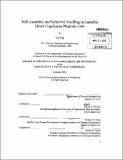| dc.contributor.advisor | Edwin L. Thomas and Bradley D. Olsen. | en_US |
| dc.contributor.author | Fan, Yin, Ph. D. Massachusetts Institute of Technology | en_US |
| dc.contributor.other | Massachusetts Institute of Technology. Department of Chemical Engineering. | en_US |
| dc.date.accessioned | 2014-05-23T19:42:43Z | |
| dc.date.available | 2014-05-23T19:42:43Z | |
| dc.date.copyright | 2014 | en_US |
| dc.date.issued | 2014 | en_US |
| dc.identifier.uri | http://hdl.handle.net/1721.1/87534 | |
| dc.description | Thesis: Ph. D. in Polymer Science and Technology, Massachusetts Institute of Technology, Department of Chemical Engineering, 2014. | en_US |
| dc.description | Cataloged from PDF version of thesis. | en_US |
| dc.description | Includes bibliographical references. | en_US |
| dc.description.abstract | Materials with responsive structural color have broad applications ranging from sensing to smart coating. Nature provides inspirations for the design of such materials. Mimicking the structure of the skin elements responsible for cephalopod's fast camouflage, we made photonic gels using lamellar block copolymer (BCP) films. Diblock copolymer poly(styrene-b-2-vinylpyridine) (PS-P2VP) of symmetric composition self-assembles into alternating PS and P2VP layers parallel to the substrate after solvent vapor annealing. In solvents that are selective to P2VP, the P2VP layers swell while the PS layers remain glassy. The glassy PS layers restrict the lateral expansion of the P2VP layers, and therefore the swelling of P2VP layers occurs only along the direction normal to the layer surface. The 1D swelling turns the lamellar BCP film into a Bragg stack comprised of alternating gel and glass layers, which reflects light in the visible regime. The BCP gels display responsive structural color to a variety of stimuli triggered by the swelling/deswelling of the gel layers, and can be used to indicate changes in the solution properties of the gel block in the selective solvent. The thesis first looks into developing temperature-responsive or thermochromic photonic gels. The first example is a PS-P2VP/acetic acid photonic gel. P2VP has a temperature-dependent basicity and its swelling ratios in acetic acid solutions vary with temperature as degrees of protonation change. The PS-P2VP/acetic acid photonic gels showed blue-shifts in the reflection color at high temperatures which can be tuned by acid concentration, valency and counterion species. The second example of temperature-responsive photonic gels is PS-P2VP/ cyclohexane. The PS - cyclohexane pair has an upper critical solution temperature (UCST) and the photonic gel's structural color red-shifts at high temperature. The temperature dependence can be tuned by the molecular weight of the PS-P2VP. Next we show that the PS-P2VP photonic gels are also responsive to the composition of alcohol-water co-solvents. A model based on Flory-Huggins mixing and line defect network strain energy quantitatively relates the photonic gel's reflectivity to the Flory-Huggins interaction parameter X between P2VP and the co-solvent and the average defect density. The results indicate that the edge and screw dislocation line defects in lamellar self-assembly serve to create an interconnected network of glassy PS layers that restrict the selective swelling and hence the photonic response. The co-solvent quality responsive photonic gels provide a method to measure the Flory-Huggins y parameter and the defect density in the lamellar BCP film. Proteins can form ionic complexation with polyelectrolytes. The P2VP block in the lamellar PS-P2VP is converted into a polycation QP2VP by quatemization reactions. The ionic complexation between proteins and QP2VP triggers the swelling/deswelling of the QP2VP gel block, which changes the structural color of the lamellar PS-QP2VP photonic gels. We demonstrate that counterion coacervation as a novel mechanism to trigger the photonic responses of the BCP gels. Exposure to aqueous solutions of proteins alters the swelling ratios of the QP2VP gel layers in the PS-QP2VP gels due to the ionic interactions between proteins and the polyelectrolyte block. The real-time photonic responses of the PS-QP2VP gels are characterized by the reflective spectra recorded as a function of time and are related to the dynamic swelling behaviors of the QP2VP gel layers in protein solutions. The results suggest that the BCP gels and their associated structural colors provide a fast and visually interpretable method to differentiate different proteins due to their differences in size and charge. | en_US |
| dc.description.statementofresponsibility | by Yin Fan. | en_US |
| dc.format.extent | 162 pages | en_US |
| dc.language.iso | eng | en_US |
| dc.publisher | Massachusetts Institute of Technology | en_US |
| dc.rights | M.I.T. theses are protected by copyright. They may be viewed from this source for any purpose, but reproduction or distribution in any format is prohibited without written permission. See provided URL for inquiries about permission. | en_US |
| dc.rights.uri | http://dspace.mit.edu/handle/1721.1/7582 | en_US |
| dc.subject | Chemical Engineering. | en_US |
| dc.title | Self-assembly and selective swelling in Lamellar block copolymer photonic gels | en_US |
| dc.type | Thesis | en_US |
| dc.description.degree | Ph. D. in Polymer Science and Technology | en_US |
| dc.contributor.department | Massachusetts Institute of Technology. Department of Chemical Engineering | |
| dc.identifier.oclc | 879680290 | en_US |
